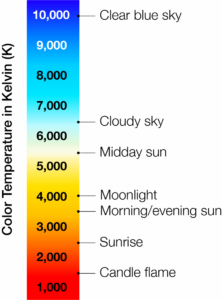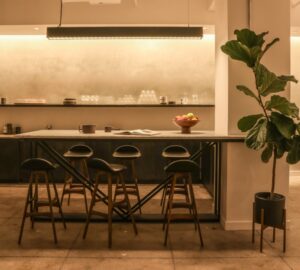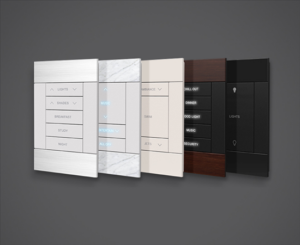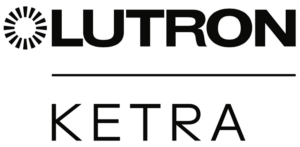Of all the amenities in a home, lighting can have the most impact on design, ambiance and even your sense of well-being. Set at the appropriate brightness and color temperature, lighting can accentuate the architectural features of your home while affecting your mood and well-being. Smart lighting has the ability to touch every part of our lives in some very positive ways, and the continual evolution of LED lighting technology is largely responsible. LED lighting has also introduced a new approach to lighting design, called Human-Centric Lighting, or HCL*. Able to simulate daylight and dusk and develop a deeper connection with the outdoors, Human-Centric Lighting offers an exciting new approach to home lighting.
Able to simulate daylight and dusk and develop a deeper connection with the outdoors, Human-Centric Lighting offers an exciting new approach to home lighting.
The objective of Human-Centric Lighting is to enhance the human experience, in particular, to satisfy our craving for natural sunlight. This involves advanced lighting solutions that simulate the shifting color spectrum and intensity of light throughout the day. This simulated natural light seamlessly blends with daylight, so you can start your day with bright, energizing light, and wind down with the same warm evening glow that you would experience outdoors as the sun starts to set.
How Modern LED Lighting Solutions Deliver HCL
 The simulation of sunlight throughout the day is achieved through “tunable light” with a dynamic color spectrum. Visible light is composed of a spectrum of colors that range across the “rainbow” of colors and includes white light – which is a combination of various color wavelengths. Most LED or fluorescent lights can produce only a single color temperature, limiting homeowners to that one color – and even incandescent lighting, which can “warm” in color as it dims, is not tunable.
The simulation of sunlight throughout the day is achieved through “tunable light” with a dynamic color spectrum. Visible light is composed of a spectrum of colors that range across the “rainbow” of colors and includes white light – which is a combination of various color wavelengths. Most LED or fluorescent lights can produce only a single color temperature, limiting homeowners to that one color – and even incandescent lighting, which can “warm” in color as it dims, is not tunable.
Innovative LED lighting companies now offer dynamic spectrum lighting, which allows light to be tuned across the visible spectrum of colors and enables a wide range of whites, pastels, and saturated colors to be created from a single light source.
Research has demonstrated the effect that natural light can have on our sense of well-being, and how tailored lighting can transform our perception of a space and everything within it. Both natural light and custom lighting scenes provide solutions to optimize a space, whether mimicking shifting sunlight throughout the day or adding bright white morning light to a space before the sun has risen to help energize and kick-start your day.
Tunable light can create dramatic effects with artwork, too. Subtle, nearly imperceptible changes in the lighting’s color spectrum can make the art look more dramatic, bringing focus to certain colors within the art and invoking an entirely different feel. Once homeowners, architects, and designers experience the impact of dynamic lighting, they find it hard to return to static lighting.
Once homeowners, architects, and designers experience the impact of dynamic lighting, they find it hard to return to static lighting.
Bringing Human-Centric Lighting Into the Home
Advanced lighting solutions make it easy to implement Human-Centric Lighting in a home, where it is possible to program an automated scene that progresses throughout the day – reducing artificial blue light in the evening and mimicking the patterns of real sunlight with a warm evening glow, for example.
But HCL solutions go beyond simulated natural light, offering endless possibilities for customizations that fit each homeowner’s preferences. Curated content provides alternate or additional settings that illuminate specific activities and moods, enabling lighting scenes to fit any homeowner’s lifestyle.
Examples of Human-Centric Lighting applications beyond the simulation of natural light cycles include:
- Setting the mood. Lighting set at a bright level and cool light temperature and intensity can energize a morning shower or late-night work session; warm and dim lighting can set the scene for a relaxing evening bath after a long day at the office.
- Anticipating real-world lighting when getting ready. Lighting conditions can transform beauty and fashion statements, and help optimize grooming routines. The ability to adjust the lighting in anticipation of a range of activities whether a candlelit dinner, mid-afternoon board meeting or sunset walk, can help put you in the right frame of mind.
- Creating drama or a festive atmosphere. Custom lighting scenes can dynamically create layers of light that create the perfect atmosphere for hosting and celebrating – whether it’s highlighting artwork and decorative objects, accenting a space with saturated colors for a party, or recalling scenes that create depth and drama in a multi-purpose room.
There are two main ingredients needed for HCL:
- Tunable lighting sources. These may include tunable lighting fixtures, such as a recessed ceiling fixture, a tuneable lamp (light bulb), or tuneable strip lighting (also known as “tape lights”).
- A control system capable of “telling” the lighting fixtures to change their color temperature and intensity level.
 There are two different broad categories of tunable lighting sources. One category is known as “tuneable white.” There is a wide range of color temperatures that are considered “white” light. For example, “daylight” or “cool white” lamps look good and are appropriate for lighting an interior space in the middle of the day, especially at an office. In the evening, though, they look harsh and almost blue-white. “Warm white” lamps look great in the evening, especially at sunset and after, though they look almost yellow-white mid-day, especially when positioned near a window.
There are two different broad categories of tunable lighting sources. One category is known as “tuneable white.” There is a wide range of color temperatures that are considered “white” light. For example, “daylight” or “cool white” lamps look good and are appropriate for lighting an interior space in the middle of the day, especially at an office. In the evening, though, they look harsh and almost blue-white. “Warm white” lamps look great in the evening, especially at sunset and after, though they look almost yellow-white mid-day, especially when positioned near a window.
The next category of lighting fixture is able to change literally into millions of shades of color. This flexibility not only allows for HCL, it also allows for dramatic and fun lighting scenes for special occasions. Do you want to have the entire room red, green, orange, blue, or some combination thereof for a party? No problem with infinite color lighting fixtures!
You can experiment with these lighting effects with the popular Philips Hue brand of lamps and similar DIY products, though the major downfall with DIY solutions is their reliance on using smartphone and tablet apps for control of all lighting functions. In addition, DIY color-changing products are not meant for easy whole-house control, plus the quality of light (known as CRI or “color rendering index”) will not compare to professionally-installed solutions.
Professionally installed lighting solutions, such as provided by HTA Certified home technology professionals, are the best solution. There are several lighting systems available; what they have in common are easy-to-use wall-mounted lighting keypads in place of conventional switches and dimmers, and the ability to change lighting color automatically. All modern lighting control systems work with smartphone and tablet apps and home automation systems, too.
Lighting keypads come in different colors and finishes; there is a lighting control solution for every home, from the most cutting-edge modern to classic and traditional. Instead of multiple dimmers or switches lined up next to each other (wall acne!), a single lighting keypad replaces them all. The lighting keypads generally have a few different lighting “scenes” programmed into them, with engraving to tell you what each scene does. The buttons on a lighting keypad pack a lot of power into a single button press. A single button can turn on a single light, a room full of lights, recall a preset lighting scene, or turn on or off all of the lights in the entire house.See a sample variety of lighting keypads here:
 These advanced lighting systems can automatically tune the lighting fixtures to mimic the color temperature of natural outdoor light. The shift in color temperature occurs smoothly, you will not even notice it is happening as the lighting will feel natural and “right” for the time of day.
These advanced lighting systems can automatically tune the lighting fixtures to mimic the color temperature of natural outdoor light. The shift in color temperature occurs smoothly, you will not even notice it is happening as the lighting will feel natural and “right” for the time of day.
Architect and interior designers are becoming more aware of Human-Centric Lighting and the aesthetic and wellness benefits it can bring. They should reach out to HTA Certified home technology designers to get their specific questions answered to learn more; the earlier in the design process, the better (click here to read why home technology designers need to be engaged early in a home’s design process). Nearly 100% of HTA Certified firms design and install lighting control systems capable of HCL. Some have lighting designers on staff, some sell tunable lighting fixtures, and some even have electrical licenses so they can handle the entire home’s electrical systems, too. For the firms that do not offer lighting design and fixtures in-house, they will have third-party partners they work with to design and install a complete HCL solution. This includes working with outside lighting design professionals (you can see which home technology systems and services they offer by scrolling to the “Systems Offered” section of their profile on the HTA Certified designer finder).
Human-Centric Lighting will continue to grow in popularity as homeowners become more aware of the solutions available to help them live a more holistic, nature-inspired lifestyle at home. What’s more, we anticipate a continued trend towards personalization – with the capacity to update lighting to extend daylight indoors as the seasons shift, create custom scenes that fit specific homeowner activities and moods, or otherwise tailor-based on each homeowner’s preferences. A growing awareness of dynamic, full-spectrum lighting is already creating increased demand for lighting solutions that can be personalized for the time of day, activity and mood – and we expect that high quality, tunable light with a high degree of personalization will one day become the standard for all spaces that we occupy.
 Use the HTA technology budget calculator to create a lighting system estimate by clicking here (the budget calculator creates a lighting control budget; HCL lighting fixtures are an additional cost to the lighting control system).
Use the HTA technology budget calculator to create a lighting system estimate by clicking here (the budget calculator creates a lighting control budget; HCL lighting fixtures are an additional cost to the lighting control system).
Human-Centric Lighting will continue to grow in popularity as homeowners become more aware of the solutions available to help them live a more holistic, nature-inspired lifestyle at home
This article was created with help from Liana Frey, Vice President of Marketing, Ketra
Founded in 2009, Ketra offers high-quality light that is flexible and adjustable, allowing for tailored lighting solutions to meet any consumer needs. Ketra’s revolutionary Natural Light gradually shifts in color temperature and intensity to mimic the sun, making spaces feel seamlessly bathed in sunlight. With over 71 U.S. patents, the Ketra system is comprised of LED luminaires and lamps, software and driver chip technology. In 2018, Ketra was acquired by Lutron Electronics. In joining the Lutron family, Ketra gained a tenured team of experts from Lutron’s 60-year history that bring wisdom and top-notch quality and service. Learn more at ketra.com
* Home Technology Association note: HCL is sometimes referred to as “Circadian Rhythm Lighting,” although HCL is a much broader concept dealing with more than circadian rhythms. A circadian rhythm is a natural, internal process that regulates the sleep-wake cycle and repeats roughly every 24 hours. This article on undark.org discusses more circadian rhythm lighting information > Age of Enlightenment
